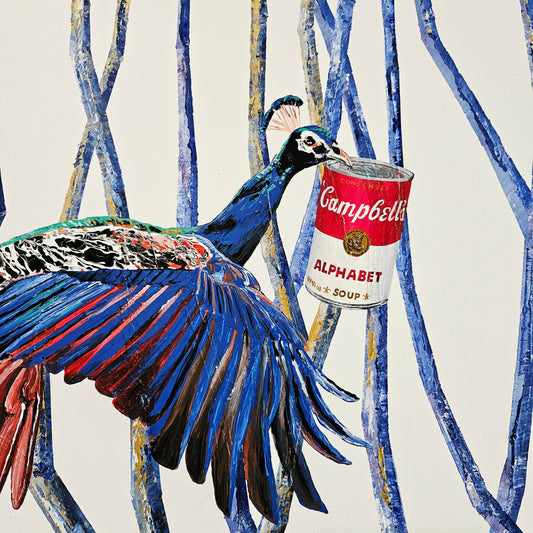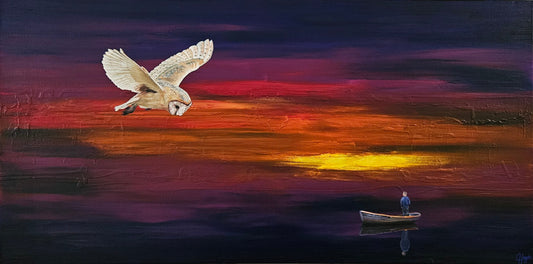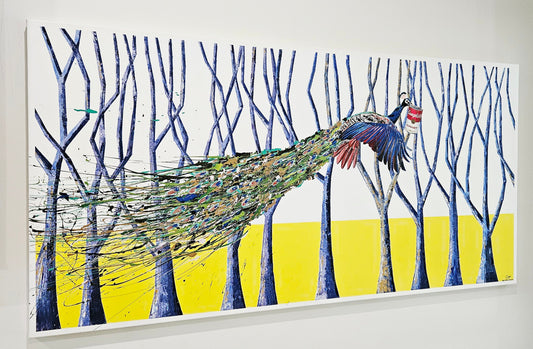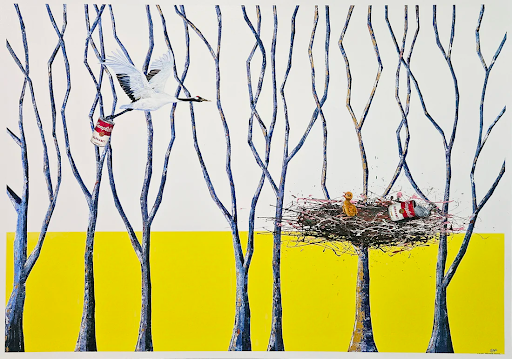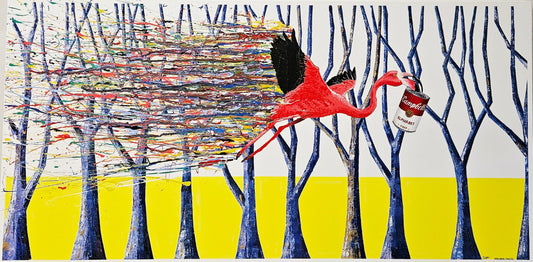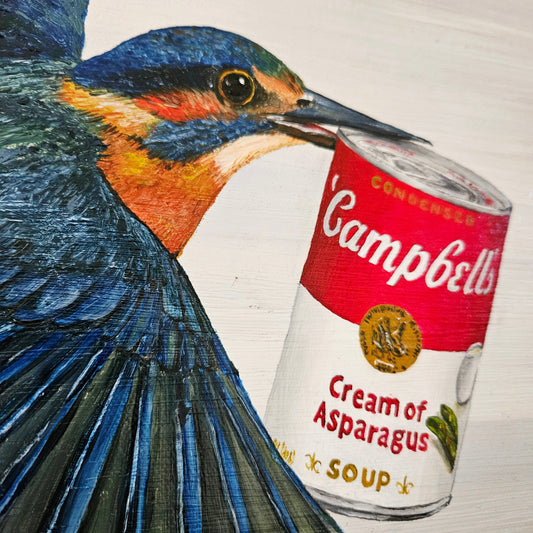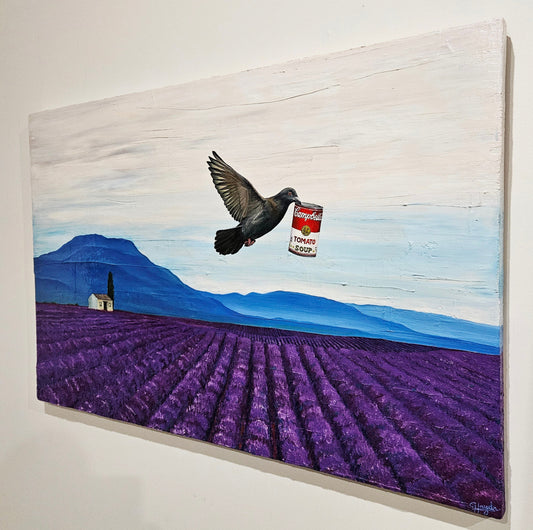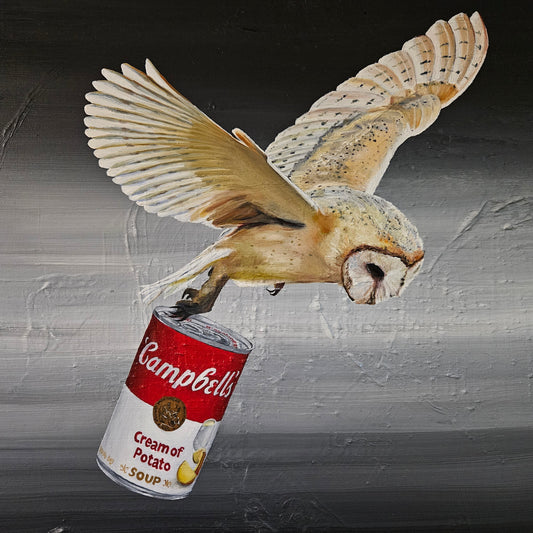The Flight by Haydn: Capturing Freedom and Purpose in the Elegance of a Great Egret

The Flight by Haydn – A Majestic Oil Painting Celebrating the Grace and Freedom of the Great Egret
Discover The Flight by Haydn, a stunning oil painting that portrays a great egret's elegance, determination, and natural beauty in mid-flight against a serene, dreamlike sky.
The Flight: A Visual Symphony of Freedom, Purpose, and Natural Elegance
In contemporary wildlife art, few subjects embody grace and serenity like the great egret. In his remarkable oil painting The Flight, Haydn captures not only the physical beauty of this majestic bird but also the profound sense of purpose and freedom that its flight symbolises. Measuring 60cm in height by 80cm in width, framed elegantly in a black floating frame, The Flight is a masterful composition that combines technical precision, emotional depth, and artistic expression.
At first glance, the viewer is drawn to the egret, a figure of striking purity, its pristine white feathers catching the light as it soars effortlessly through the air. The bird's motion seems powerful and delicate, with wings fully extended in a graceful arc. It is a moment suspended in time, a fleeting glimpse of nature’s quiet elegance rendered with extraordinary care and sensitivity.
Those who wish to view the painting can find it on Bluethumb.
The Great Egret: A Symbol of Grace and Resilience
The choice of the great egret as the focal point of this painting is significant. Across cultures and traditions, the egret has long been a symbol of purity, resilience, and spiritual connection. Its tall, slender form and slow, deliberate movements have earned it a place in folklore and art as a creature of patience and grace.
In Native American symbolism, the egret represents self-reliance and independence. It is admired for its ability to thrive in solitary environments. It is often seen standing alone in shallow waters, waiting patiently for the perfect moment to strike. This deliberate, purposeful action quality is beautifully echoed in Haydn’s The Flight, where the egret’s poised form conveys not just movement but intention.
In Eastern philosophies, particularly within Japanese and Chinese cultures, white birds like the egret are seen as messengers of the divine, embodying peace and purity. Their flight is often interpreted as a metaphor for spiritual ascension or the journey towards enlightenment. In Western art, the egret has also come to symbolise resilience, having been brought back from the brink of extinction due to conservation efforts, which adds a layer of meaning to any contemporary depiction.
The Composition: Balance Between Detail and Atmosphere
Haydn’s artistic skill is evident in his careful balance of intricate detail and atmospheric softness. The egret’s feathers are rendered with delicate, confident brushstrokes, each layer capturing the texture and translucency of the plumage. The light dances across the bird’s body, accentuating the form without overwhelming it. Subtle hints of blue and grey define the shadows, adding depth and dimension to the otherwise luminous figure.
The background, however, takes a different approach. Haydn employs an ethereal blend of faded violets and purples, applied in a dreamy, almost impressionistic style. These hues suggest the soft light of dawn or dusk, the transitional hours when the world seems full of promise and tinged with reflection. The background serves not merely as a backdrop; it creates an emotional atmosphere that enhances the viewer’s connection to the subject.
The result is a composition that feels both dynamic and serene. The viewer’s eye is drawn naturally from the sharp yellow beak, pointing purposefully towards an unseen destination, along the sinuous neck curve, and across the expansive wings before trailing off with the black legs that extend gracefully behind. Every element of the painting contributes to a sense of effortless motion and quiet determination.
Light and Motion: Capturing a Fleeting Moment
One of The Flight's most striking aspects is how Haydn captures the interplay of light and motion. The gentle blending of colours and the feather-light quality of the brushwork give the painting a sense of movement that transcends the canvas. The egret appears to be flying and gliding through a space where time has momentarily paused.
This effect is enhanced by the soft diffusion of light across the scene. The light emanates from multiple sources, perhaps the last rays of a setting sun or the first light of morning. This ambiguity allows viewers to project their interpretations onto the scene, making it a personal and reflective experience.
The depiction of motion is equally masterful. While the egret is in mid-flight, there is no sense of struggle or exertion. Instead, the movement appears natural, inevitable, and serene. This portrayal reinforces the painting's symbolic meaning: the idea that purpose and progress can be achieved with grace and composure, even in the face of challenges.
Emotional and Philosophical Resonance
Beyond its visual beauty, The Flight resonates deeper emotionally and philosophically. The themes of freedom, purpose, and the transient nature of beauty are woven seamlessly into the composition.
Freedom is the most immediate and universal theme. The egret’s expansive wings and the open space around it evoke a sense of liberation, not just physically but also emotionally and spiritually. They speak to the desire to break free from constraints and move confidently and clearly towards one’s goals.
The egret’s posture and direction embody purpose. There is nothing aimless about its flight. The bird’s focus and determination are evident, serving as a metaphor for pursuing goals, dreams, or personal growth. It reminds viewers that even the most graceful journeys require intention and resolve.
The fleeting moment that the painting portrays captures the transient nature of beauty. Birds in flight are a common symbol of impermanence, reminding us that all things, both challenges and triumphs, are temporary. This awareness can inspire appreciation and mindfulness.
The Role of Colour and Form
The choice of colour in The Flight is aesthetically pleasing and emotionally evocative. The soft purples and violets of the background suggest both calmness and depth. Purple is often associated with wisdom, dignity, and spiritual awareness, all of which align with the themes present in the painting.
The egret's elegant form, with its sweeping curves and elongated lines, enhances the painting. The arcs of the wings and neck create a sense of flow and continuity, guiding the viewer’s gaze and reinforcing the feeling of motion.
Connection to the Viewer: An Invitation to Reflect
What makes The Flight particularly compelling is its ability to connect with viewers on a personal level. While the painting depicts a specific bird in a particular moment, it also serves as a mirror for human experiences and emotions.
Viewers may see their journeys, past, present, or future, in the egret's flight. The painting can evoke memories of times when they pursued goals with determination or experienced the freedom of letting go. It can also inspire contemplation about the direction of one’s life and the importance of moving forward with purpose.
This universality is a hallmark of great art. It transcends the particulars of subject and technique to engage with the viewer’s inner world, prompting reflection, emotion, and connection.
Technical Mastery: Bridging Realism and Impressionism
Haydn’s technique in The Flight demonstrates a sophisticated understanding of realism and impressionism. The detailed rendering of the egret’s plumage reflects a realist’s attention to accuracy and form, while the impressionistic background allows for emotional expression and atmospheric depth.
This blending of styles creates a painting that is both grounded and ethereal. It captures the subject's physical reality while also conveying the mood and emotion of the moment.
The use of oil paint further enhances the work. Oils allow for rich colour saturation, subtle blending, and a depth of texture that brings the scene to life. A black floating frame adds a modern touch, lighting the painting without detracting from its softness and warmth.
The Flight as a Celebration of Nature and the Human Spirit
The Flight is more than a depiction of a bird in motion. It is a celebration of nature’s beauty, a meditation on purpose and freedom, and an invitation to reflect on one’s journey. Through his masterful use of colour, form, and symbolism, Haydn has created a work that resonates across time and culture.
The painting’s serene elegance and emotional depth make it a standout piece in any collection, whether displayed in a home, office, or gallery. It serves not only as a visual focal point but also as a source of inspiration and contemplation.
For those who appreciate wildlife art that combines technical skill with philosophical resonance, The Flight offers a rare and rewarding experience.
To view The Flight, visit Bluethumb.

